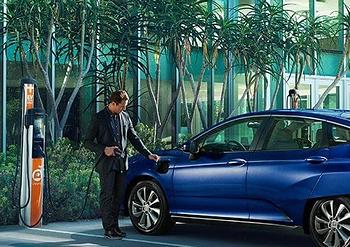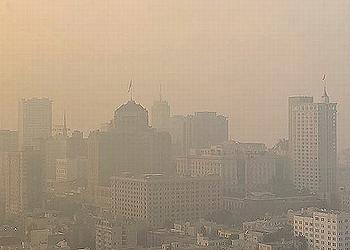
SACRAMENTO, California, July 26, 2019 (ENS) – As the Trump administration prepares to roll back emission standards for light-duty cars and trucks, a consortium of four automakers and the state of California have agreed on a voluntary framework to reduce emissions as an alternative path forward for clean vehicle standards nationwide.
Automakers who agreed to the framework are Ford, Honda, BMW of North America and Volkswagen Group of America.

The framework supports continued annual reductions of vehicle greenhouse gas emissions through the 2026 model year, encourages innovation to accelerate the transition to electric vehicles, and provides industry the certainty needed to make investments and create jobs.
This commitment means that the auto companies party to the voluntary agreement will only sell cars in the United States that meet these standards.
“Few issues are more pressing than climate change, a global threat that endangers our lives and livelihoods. California, a coalition of states, and these automakers are leading the way on smart policies that make the air cleaner and safer for us all,” said California Governor Gavin Newsom.
“I now call on the rest of the auto industry to join us, and for the Trump administration to adopt this pragmatic compromise instead of pursuing its regressive rule change,” Newsome said. “It’s the right thing for our economy, our people and our planet.”
Under the framework, gasoline and diesel cars and light trucks will get cleaner through 2026 at about the same rate as they would under the current program, adopted under the Obama administration.
The California framework also supports a national program that will result in at least 30 percent more greenhouse gas emission reductions compared to splitting up the standards between those followed by California and 13 other states and the less stringent standards proposed by the Trump administration.
“This agreement represents a feasible and acceptable path to accomplishing the goals of California and the automobile industry,” said California Air Resources Board Chair Mary Nichols.
“If the White House does not agree, we will move forward with our current standards but work with individual carmakers to implement these principles,” said Nichols. “At the same time, if the current federal vehicle standards proposal is finalized, we will continue to enforce our regulations and pursue legal challenges to the federal rule.”
The agreement comes as the Trump administration is preparing to roll back federal vehicle emission standards, freezing them at the 2020 level through the 2026 model year. This move threatens air quality and health for millions of Americans, would increase costs to consumers, and promises to further set back U.S. efforts to combat climate change, Governor Newsom’s office said in a statement.
The rollback has faced growing opposition from a broad array of governors and mayors, auto companies, labor, consumer groups, public health organizations, and environmental groups.
Earlier this month, a bipartisan coalition of 24 governors representing more than half the U.S. population came together in calling for a stronger, national clean car standard.

In their statement, entitled “The Nation’s Clean Car Promise,” the governors called for a commonsense approach that protects the role of states at the negotiating table and establishes a strong, national standard.
“We must unite to ensure a strong, science-based national standard, in California and across the country, that increases year-over-year, provides certainty for automakers and consumers, reduces greenhouse gases, and protects public health,” the 24 governors said.
The statement is signed not just by the 13 states that follow California’s clean car standards, but by 10 additional states led by both Republican and Democratic governors. Together, this bipartisan coalition represents 57 percent of the U.S. economy and more than half of U.S. annual auto sales.
In June, the California Air Resources Board signed a Memorandum of Understanding with Canada committing both governments to work together on developing their respective regulations to cut emissions from light-duty vehicles, such as those currently in effect in Canada, California and the 13 U.S. states that have adopted California’s standards.
Trump’s proposed rollback threatens to pump billions of tons of climate-altering greenhouse gases, as well as millions of tons of particulate matter and ozone-causing pollutants, into the atmosphere. By the U.S Environmental Protection Agency’s own estimates, health-related costs from the rollback could be as much as $12 billion nationally by 2025.
In a letter last month, 17 worldwide automakers appealed to the White House and California to work together on a single national standard, warning of uncertainty for the auto market and noting that auto industry jobs are at stake.
The terms of the California framework will deliver the same greenhouse gas reductions in five years as the original Obama standards would have achieved in four.
This provides a path forward that allows California and other states to meet their climate and clean air goals and maintains a national approach for participating automakers who will sell these cleaner cars nationwide. The framework also supports the long-term electrification goals of California and the carmakers.
The terms of the framework also make it clear that California must maintain its authority under the Clean Air Act to establish emissions rules because of its unique air quality, public health and climate challenges.
“California’s authority to set tough vehicle emission standards has been good for California and the country,” said Governor Newsom. “This agreement affirms the fact that retaining that authority is a crucial element in our ability to make progress with cleaner cars.”
The Framework
The framework agreed to by the automobile companies and California benefits the country by achieving continuous annual reductions in greenhouse gas emissions and criteria pollutants while saving consumers money. Terms of the framework include:
• Extending the current 2025 model year standard until 2026 and smoothing out the interim years from 2022 through 2025 to provide additional lead time and slightly less aggressive year-over-year reductions. It changes the original year-over-year 4.7 percent greenhouse gas reduction over four years to 3.7 percent over five years.
• Supporting the transition to electric vehicles by rewarding companies that sell more EVs with additional credits to meet the greenhouse gas standard for their entire fleet, while ensuring that gas and diesel vehicles also get progressively cleaner over time.
• Providing an incentive to car companies to install more greenhouse gas-reducing technologies by modestly revising limitations on their usage, and streamlining agency review and approval for new technologies.
• Simplifying compliance by removing the requirement to consider upstream greenhouse gas emissions associated with the production of the electricity used by electric vehicles when calculating the greenhouse gas emissions for an automaker’s fleet.
• Participating companies are choosing to pursue a voluntary agreement in which California accepts these terms as compliance with its program, given its authority, rather than challenge California’s greenhouse gas and zero-emission vehicles programs.
Vehicle Pollution and California

Vehicle emissions in California are responsible for nearly 40 percent of greenhouse gases and more than 40 percent of smog-forming emissions. The stakes are high for the health of Californians, and the framework agreement on principles will still allow the state to improve conditions that threaten public health.
Currently, 32 million Californians breathe ozone or particle polluted air at some point each year.
Ten million Californians currently live in the only two “severe non-attainment” areas in the United States for ozone. They face a higher risk of severe heart and breathing problems than Californians living elsewhere.
Vehicle emissions are partly responsible for the steadily warming climate, which drives drought and more intense wildfires and increases polluted air and the associated health risks.
California has fought hard for its air quality improvements over the past 50 years. In the Los Angeles area, eight-hour ozone levels have fallen 45 percent since 1990.
But California still must achieve an 80 percent reduction in smog in the Los Angeles region and about a 50 percent reduction of smog in the San Joaquin Valley to achieve its health-based goals, and federal air quality requirements.
Copyright Environment News Service (ENS) 2019. All rights reserved.
